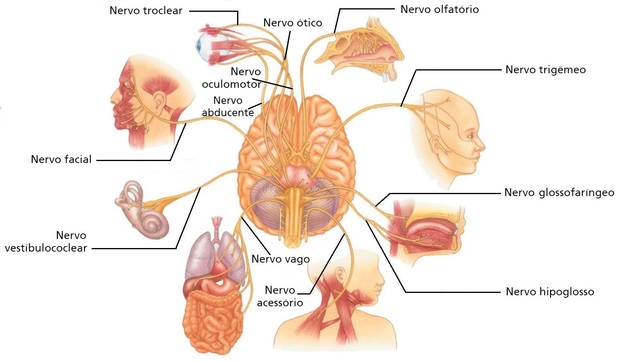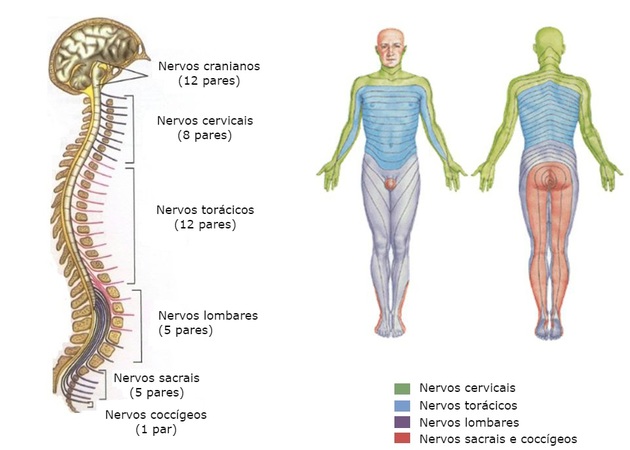The nerves of the human body are structures formed by nerve fibers and connective tissue.
They are responsible for the transmission of nerve impulses (electrical impulses), known as “action potential”.
The nerves are distributed throughout the human body, and begin in the brain and spinal cord.
Its main function is to establish the communication of Organs motor and sensory organs, all through the central nervous system.
Nerve Structure

Nerves are filamentary structures, that is, cables or bundles of nerve fibers formed by axons (motor fibers) and dendrites (sensitive fibers).
Its covering is made of connective tissue , which are classified as follows:
- Epineuro : corresponds to the fibrous layer and helps to fill the spaces between the fiber bundles.
- Perineuro : corresponds to a sheath of cells that lines the bundles of fibers.
- Endoneuro : located inside the perineurium, it is another layer of fibers.
They are considered appendages of the axons of nerve cells, which make the connections between the nervous system and the human body.
Nerve Classification
Nerves can be classified in different ways, varying according to the type of fiber that makes them up.
See in the table below what these types are and their characteristics.
| Nerve classification | Feature |
|---|---|
| Afferent | Formed by sensory nerves, afferent nerves send signals from the periphery of the body to the central nervous system through sensory signals (fibers). |
| Efferent | Called motor nerves (fibers) , efferent nerves send signals from the central nervous system to muscles or glands through stimulating signals. |
| Mixed | In this case, the nerves are formed by sensory fibers and motor fibers , for example, the spinal nerves. |
What are the nerves of the human body?
In the human body, the nervous system is classified into: Central Nervous System (CNS) and Peripheral Nervous System (SNP).
The Central Nervous System is formed by the brain and the spinal cord. The Peripheral Nervous System, on the other hand, consists of nerves that come out of the brain, called cranial nerves, and nerves originating in the spinal cord, called spinal or spinal nerves.
Thus, the nerves of the human body are part of the Peripheral Nervous System, being characterized as a communication network that runs throughout the body. Its function is to connect the central nervous system with the organs .
The organs, in turn, are made up of sensory and motor pathways that are responsible for receiving and sending information from stimuli received from the external or internal environment.
Cranial Nerves

Originating in the brain , the cranial nerves connect the sense organs (mouth, nose, ear and eyes) with the brain, which in turn innervates the part of the head, heart and lungs.
They are formed by 12 pairs of nerves. See in the table below how each pair of nerve acts in our body.
| Nerve | Feature |
|---|---|
| Olfactory nerve | With a sensitive function, it is responsible for conducting olfactory impulses. |
| Optic nerve | With a sensory function, this nerve originates in the retinal region and penetrates the skull through the optical channel. |
| Oculomotor nerve | Of motor function, this nerve is responsible for the movement of the eyes. |
| Trochlear nerve | It has a sensory and motor function and is related to eye and vision movement. |
| Trigeminal nerve | The motor function of this nerve is related to chewing. The sensory function is responsible for innervating the face, part of the scalp and internal regions of the skull. |
| Abducent nerve | This motor nerve is responsible for the innervation of the lateral rectus muscle of the eye. |
| Facial nerve | With motor and sensory function, this nerve is related to facial expressions and muscle sensitivity. |
| Vestibulocochlear nerve | With only a sensitive function, this nerve is related to balance and hearing. |
| Glossopharyngeal nerve | This nerve is responsible for the sensitivity surrounding the tongue, pharynx and auditory tube. In addition, it acts on the pharynx muscles. |
| Vacant nerve | Because it has motor and sensory function, this nerve is responsible for maintaining vital functions, such as heart rate regulation. |
| Accessory nerve | This nerve with motor function acts in the swallowing and movements of the head and neck. |
| Hypoglossal nerve | It is a nerve that is related to the movement of the tongue. |
Spinal Nerves

Originating in the spinal cord , spinal nerves (spinal nerves) are mixed nerves that branch out along the spinal cord. They are responsible for the innervation of part of the head, trunk and upper limbs.
They are composed of 31 pairs , being:
- 8 pairs of cervical nerves
- 12 pairs of thoracic nerves
- 5 pairs of lumbar nerves
- 5 pairs of sacral nerves
- 1 pair of coccygeal nerve
